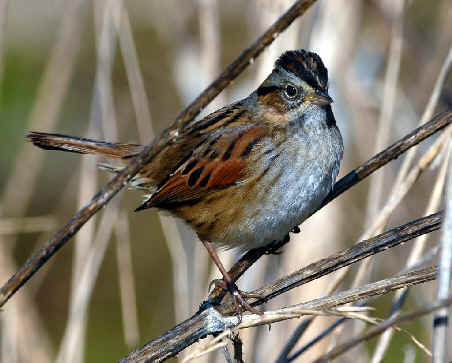The subspecies is visibly diagnosable by plumage: in breeding by having heavier black markings, a general gray-brown color on the flanks, lower back and rump, and a larger bill. In winter it is distinctive in its olive-brown rather than rusty-brown color, and larger bill.
Coastal Plain Swamp Sparrow (Photo source)
(Photo source)
(Photo source)
Feathers, when grown, can take up the isotopic signature of various elements in their environment (such as isotopes of Carbon, Nitrogen, and Hydrogen, studied here). Maps of the various isotopic gradients across the
The authors used the isotope concentrations of the rump feathers grown during the fall by the Swamp Sparrows and from male crown feathers grown from in late winter to generate an overlapping map of the three isotopes examined and narrow the likely location for the winter range of nigrescens to the coastal region of the
The authors cite one previous instance of using isotopes to identify a possible unknown winter range (Acrocephalus paludicola, Pain et al. 2004) but they believe they are the first to use isotopes to predict and then discover a population’s wintering ground. The use of isotopes often yields too coarse-grade results for useful inference, but when it succeeds the results can be very informative, as seen here.
Reference:Greenberg, R., Marra, P.P., Wooller, M.J. (2007). STABLE-ISOTOPE (C, N, H) ANALYSES HELP LOCATE THE WINTER RANGE OF THE COASTAL PLAIN SWAMP SPARROW (MELOSPIZA GEORGIANA NIGRESCENS). The Auk, 124(4), 1137. DOI: 10.1642/0004-8038(2007)124[1137:SCNHAH]2.0.CO;2



No comments:
Post a Comment